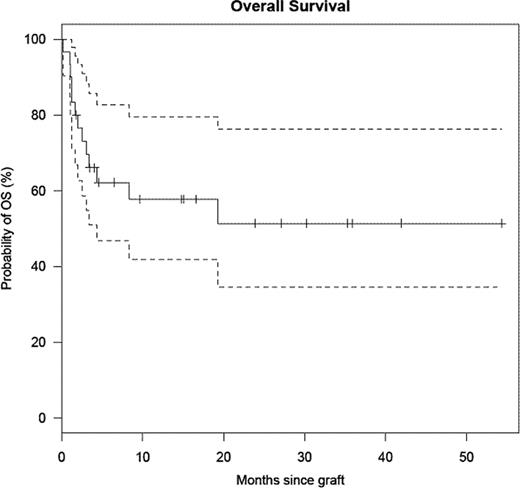Abstract
Abstract 3111
Cord blood transplantation (CB-T) is increasingly used as a treatment alternative for hematological malignancies. The use of double CB-T has leaded to interesting results in adult patients. We retrospectively evaluated 31 patients, 19 males and 12 females with a median age of 36 years (range: 20–63) who received double CB-T for hematological malignancies at our institution between 2005 and 2011. There were 15 AML, 9 ALL, 2 CML, 1 Hodgkin disease, 1 NHL, 1 MM and 1 MDS; at transplantation, 18 (58%) were in CR, 5 (16%) in PR and 8 (26%) in relapse, 16 patients received a myeloablative conditioning and 15 a reduced intensity one. Different characteristics of both CB units (CBU) are described in Table 1. When considering matching variables between the 2 CBUs and the recipient, for sex matching: in 10 cases, CBUs were both matched with the recipient, in 1 case both mismatched and in 20 cases, only 1 CBU was mismatched with recipient. For ABO compatibility, in 7 cases, CBUs were both compatible with the recipient, in 13 cases both were incompatible and in 1 case, only one was incompatible. For HLA matching, in 18 cases, both CBUs were 4/6 with the recipient and in 13 cases, only one CBU was 5/6. When considering HLA matching between the 2 CBUs, there were 7 with 3/6 HLA matching, 17 with 4/6, 6 with 5/6 and 1 with 6/6. After transplantation, 25 (81%) patients engrafted among them, 6 had mixed chimerism (presence of the 2 CBUs) and 19 had one dominant CBU. Non-engrafted patients were in relapse or progressive disease and received RIC before allo-HSCT. There were 13 patients who developed acute GVHD ≥2 (8 grade III-IV) and 6 chronic GVHD (3 limited and 3 extensive). After a median follow-up of 6.5 months (range: 1–54), the median OS was not reached with a 1 year probability of 58% (95%CI: 42–80), only 3 patients relapsed. The cumulative incidence of transplant related mortality (TRM) was 37% (95%CI: 28–46). A multivariate model that studied the different matching possibilities (sex, ABO and HLA) between the 2 CBUs together and then between the 2 CBUs with the recipient combined to CNT and CD34 cells number, showed that only the sex matching between the 3 partners can determine the dominant CBU later (p=0.04). In multivariate analysis taking into account pre-transplant and the matching variables, no factor impacted the engraftment while factors that impacted on OS were age [HR=1.1 (1.03–1.25), p=0.01], disease status at HSCT [relapse, HR=8.7 (1.4–52), p=0.01] and TNC number [ HR=0.99 (0.98–1), p=0.02]. Age and TNC number also had a significant impact on TRM [HR=1.12 (1.02–1.23), p=0.01 and HR=0.99 (0.98–1), p=0.003].
No relevant conflicts of interest to declare.
Author notes
Asterisk with author names denotes non-ASH members.



This feature is available to Subscribers Only
Sign In or Create an Account Close Modal